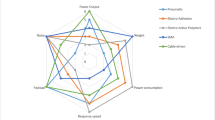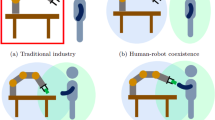Abstract
Robots have been traditionally used as positioning devices without muchregard to external forces experienced by the tool. This has limited furtherpotential applications of robots in automation. Most tasks that remain to beautomated require constrained robot motion and/or involve work done by therobot on the environment. Such tasks require both force and positioncontrol. The ability to control the end-effector compliance is critical tosuccessful force and position control tasks. Although the end-effectorcompliance can be actively controlled through the joint flexibilitiesprovided by the joint servos or by active force sensing, the usefulness ofhaving the minimum passive compliance in addition to active compliancecontrol can improve performance. In surface following, for example, it isnecessary to make the end-point of a robot have the right compliance toprevent jamming. The usefulness of passive compliance has been demonstratedby the use of compliance-devices on the robot end-effector such as theRemote Center Compliance. The natural compliance inherent in light weightand flexible robot structures, however, can be exploited to provide thenecessary passive compliance required.
In this paper we present a novel framework for computing the end-effectorcompliance from the compliance offered by the limbs of a serial robot. Theemphasis is on the explanation of the passive end-effector complianceresulting from these structures, and particular attention is given to theuse of these results in the selection of the type of robot for a particulartask. We show examples of end-effector compliances as functions of jointconfigurations for the SCARA- and PUMA-type robots. The joint-configurationdependent end-effector compliance can be used to select the desired robotpose for the performance of a robotic task.
Similar content being viewed by others
References
Goswami, A., Peshkin, M. A., and Colgate, J. E.: Passive robotics an exploration of mechanical computation, in: Proceedings of the IEEE Int. Conf. on Robotics and Automation, Cincinnati, OH, May 13–18, 1990, pp. 279–284.
Schimmels, J. M. and Peshkin, M. A.: Synthesis and validation of non-diagonal accommodation matrices for error-corrective assembly, in: Proceedings of the IEEE Int. Conf. on Robotics and Automation, Cincinnati, OH, May 13–18, 1990, pp. 714–719.
Ang, M. H. Jr.: Robots in industries: why are they not so pervasive?, in: Industrial Automation Conference (IA ’92), Singapore, May 20–23, 1992, pp. 128–142.
Mason, M. T.: Compliance and force control for computer controlled manipulators, IEEE Trans. Systems Man Cybernet. 11(6) (1981), 418–432.
Raibert, M. H. and Craig, J. J.: Hybrid position/force control of manipulators, Transactions of ASME, Journal of Dynamics Systems, Measurement and Control 102(1981), 126–133.
Schutter, J. D. and Van Brussel, H.: Compliant robot motion I. A formalism for specifying compliant motion tasks, International Journal on Robotics Research 7(4) (1988), 3–17.
Salisbury, J. K.: Kinematics and Force Analysis of Articulated Hands, Ph.D. thesis, Department of Mechanical Engineering, Stanford University, Stanford, CA, 1982.
Whitney, D. E.: Force-feedback control of manipulator fine motions, ASME Journal of Dynamic System, Measurement, and Control 98(2) (1977), 91–97.
Hogan, N.: Impedance control: an approach to manipulation: Part I–theory, Transactions of ASME Journal of Dynamic Systems, Measurements and Control 107(1) (1985), 1–7.
Kazerooni, H.: Direct drive active compliant end-effector (active RCC), International Juournal of Robotics and Automation 4(3) (1988), 324–333.
Spong, M. W. and Vidyasagar, M.: Robot Dynamics and Control, Wiley, New York, NY, 1989.
Whitney, D. E. and Nevins, J. L.: What is the remote center compliance and what can it do? in: Proceedings of 9th Int. Symposium and Exposition on Industrial Robots (ISIR), Washington, DC, March 13–15, 1979.
Hollis, R. L., Salcudean, S. E., and Peter Allan, A.: A six-degree-of-freedom magnetically levitated variable compliance fine motion wrist: design, modeling and control, IEEE Transactions on Robotics and Automation 7(3) (1991), 320–332.
Sim, T. S., Lim, K. B., and Ang, M. H. Jr.: Compliant end-effector coupling (CEEC)–a tool for general assembly, in: Proceedings of the First Chinese World Congress on Intelligent Control and Intelligent Automation, China, August 26–30, 1993, pp. 1078–1084.
Drake, S. H.: Using compliance in lieu of sensory feedback for automatic assembly, in: IFAC Symposium on Information and Control Problems in Manufacturing Technology, Tokyo, 1977.
Whitney, D. E.: Quasi-static assembly of compliantly supported rigid parts, Transactions of ASME, Journal of Dynamic Systems, Measurement and Control 104(1) (1982), 65–77.
Andeen, G. B. and Kombluh, R.: Design of compliance in robotics, in: Proceedings of the IEEE Int. Conf., on Robotics and Automation, Philadelphia, PA, April 24–29, 1988, pp. 276–281.
Andeen, G. B. (ed.): Robot Design Handbook. McGraw-Hill, New York, NY, 1988.
ElMaraghy, H. A. and Johns, B.: An investigation into the compliance of SCARA robots, Parts I–II, Transactions of ASME, Journal of Dynamic Systems, Measurement and Control 110(1) (1988), 18–22.
Thomson, W. T.: Theory of Vibration with Application, Prentice-Hall, Englewood Cliffs, NJ, 3rd ed., 1988.
Andeen, G. B. and Ang, M. H. Jr.: Compliance for manipulators with nonbackdrivable actuators, in: Proceedings of the Asia-Pacific Industrial Automation (IA)’90 Conference, Singapore, May 23–26, 1990, pp. 197–212.
Leipholz, H.: Theory of Elasticity, Nordhoff International Publishing, Leiden, 1974.
Lancaric, J.: Geometrical Analysis of Compliant Mechanisms in Robotics, Ph.D. dissertation, Harvard University, 1985.
Patterson, T. and Lipkin, H.: Structure of robot compliance, Transactions of ASME, Journal of Mechanical Design 115(1993), 576–580.
Patterson, T. and Lipkin, H.: A classification of robot compliance, Transactions of ASME, Journal of Mechanical Design 115(1993), 581–584.
Dawe, D. J.: Matrix and Finite Element Displacement Analysis of Structures, Clarendon Press, Oxford, U.K., 1984.
Craig, J. J.: Introduction to Robotics: Mechanism and Control, Addision-Wesley, 2nd ed., 1989.
Fu, K. S., Gonzalez, R. C., and Lee, C. S. G.: Robotics: Control, Sensing, Vision, and Intelligence, McGraw-Hill, 1987.
Mason, M. T.: Compliant motion, in: M. Brady et al. (eds), Robot Motion: Planning and Control, Mit Press, Cambridge, MA, 1983, pp. 305–332.
Bruyninckx, H. and Schutter, J. D.: Specification of force-controlled actions in the task frame formalism–a synthesis, IEEE Transactions on Robotics and Automation 12(4) (1996), 581–589.
Ang, M. H. Jr. and Andeen, G. B.: Specifying and achieving passive compliance based on manipulator structure, IEEE Transactions on Robotics and Automation 11(4) (1995), 504–515.
Author information
Authors and Affiliations
Rights and permissions
About this article
Cite this article
Ang Jr., M.H., Wang, W., Loh, R.N.K. et al. Passive Compliance from Robot Limbs and its Usefulness in Robotic Automation. Journal of Intelligent and Robotic Systems 20, 1–21 (1997). https://doi.org/10.1023/A:1007952828908
Issue Date:
DOI: https://doi.org/10.1023/A:1007952828908




